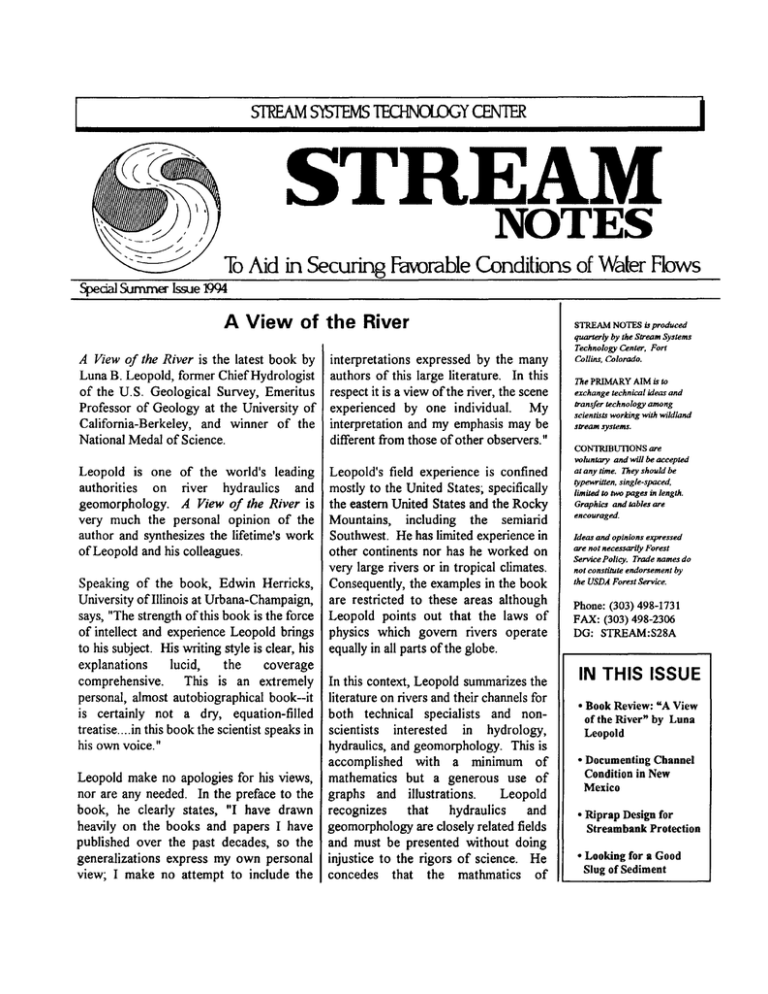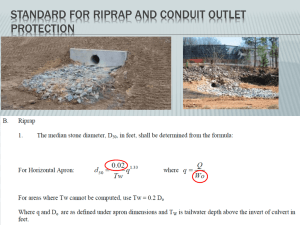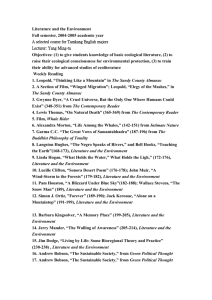Document 10550815
advertisement

I CENTER To Aid in Favorable Conditions of Water Flows Special Summer Issue 1994 A View of the River A View of the River is the latest book by Luna B. Leopold, former Chief Hydrologist of the U.S. Geological Survey, Emeritus Professor of Geology at the University of California-Berkeley, and winner of the National Medal of Science. interpretations expressed by the many authors of this large literature. In this respect it is a view ofthe river, the scene experienced by one individual. My interpretation and my emphasis may be different from those of other observers." Leopold is one of the world's leading authorities on river hydraulics and geomorphology. A View of the River is very much the personal opinion of the author and synthesizes the lifetime's work of Leopold and his colleagues. Leopold's field experience is confined mostly to the United States; specifically the eastern United States and the Rocky Mountains, including the semiarid Southwest. He has limited experience in other continents nor has he worked on very large rivers or in tropical climates. Consequently, the examples in the book are restricted to these areas although Leopold points out that the laws of physics which govern rivers operate equally in all parts of the globe. Speaking of the book, Edwin Herricks, University of Illinois at Urbana-Champaign, says, "The strength ofthis book is the force of intellect and experience Leopold brings to his subject. His writing style is clear, his explanations lucid, the coverage comprehensive. This is an extremely personal, almost autobiographical book--it is certainly not a dry, equation-filled treatise... .in this book the scientist speaks in his own voice." Leopold make no apologies for his views, nor are any needed. In the preface to the book, he clearly states, "I have drawn heavily on the books and papers I have published over the past decades, so the generalizations express my own personal view; I make no attempt to include the In this context, Leopold summarizes the literature on rivers and their channels for both technical specialists and non­ scientists interested in hydrology, hydraulics, and geomorphology. This is accomplished with a minimum of mathematics but a generous use of graphs and illustrations. Leopold recognizes that hydraulics and geomorphology are closely related fields and must be presented without doing injustice to the rigors of science. He concedes that the mathmatics of STREAM NOTES is produced quarterly by the Stream Systems Technology Center, Fort Collins, Colorado. The PRIMARY AIM is to exchange technical ideas and transfer technology among scientists worlcing with wild/and stream systems. CONTRIBUTIONS are voluntary and will be accepted at any time. They should be typewritten, single-spaced, limited to two pages in length. Graphics and tables are encouraged. Ideas and opinions expressed are not necessarily Forest Service Policy. Trade names do not constitute endorsement by the USDA Forest Service. Phone: (303) 498-1731 FAX: (303) 498-2306 DG: STREAM:S28A IN THIS ISSUE • Book Review: "A View of the River" by Luna Leopold • Documenting Channel Condition in New Mexico • Riprap Design for Streambank Protection • Looking for a Good Slug of Sediment • Sediment Load • The Drainage Network • River Morphology: The Most Probable State Practicing hydrologist should find Chapter 8, "Relationships Between Channel and Discharge," most informative as Leopold discusses channel capacity, effective discharge, bankfull discharge, and criteria and procedures for identifying bankfull in the field. Many of these topics were originally cover in the 1964 book by Leopold, Wolman, and Miller, Fluvial Processes in Geomorphology, which is now out of print. Those who are not fortunate enough to have access to a copy of this classic work would do well to purchase A View of the River. It covers much of the same material plus new information that has become available in recent years. hydraulics and sediment movement have become so complex that even many experts find them difficult to understand. Given this situation, Leopold does on exceptional job describing the complexities of river behavior with the minimum possible mathematics. Leopold presents a coherent description of the river, its shape, size, organization, and action, along with a consistent theory that explains much of the observed character of the channel. Chapters in the book include: • The River Channel • River Measurement • Down the Channel System • Meanders and Bars • Distribution of Discharge in Space and Time • Rivers of the World • Flow Variability and Floods • Relationships Between Channel and Discharge • The Hydraulic Geometry The book culminates in a hypothesis explaining river form. Leopold writes. "River form and action are determined by physical laws that do not dictate one and only one solution to the reaction of the channel as changes are imposed on it when seasons go from dry to wet and back to dry. Thus random chance plays a major role in local changes. As a result, the forms assumed and the adjustments made all tend toward the most probable form, expressed as the form having the least total variance." A View of the River is interesting reading both for the specialist and the general public interested in understanding and preserving rivers. It provides a worthwhile technical review for experienced scientists and a firm foundation for understanding river behavior presented in an easy to read style for the general public. A View of the River is published by Harvard University Press, 79 Garden Street, Cambridge, Massachusetts 02138. The 298 page book sells for $39.95. SYSTEMS TECHNOLOGY CENTER Documenting Channel Condition in New Mexico The Cibola National Forest has completed a study to document existing channel and meander geometry for streams in the Zuni Mountains ofwestern New Mexico. Study sites representative of streams in the Zuni Mountains and U.S. Geological Survey gaging stations were analyzed to determine bankfull discharge and channel and meander geometry. Regional curves for bank:full discharge and average bank:full dimensions as a function of drainage area were developed. These curves complement similar curves developed for other parts of the United States previously published in Water in Environmental Planning by Dunne and Leopold and add to our understanding of regional stream differences. The results of this study are included in a report titled "Zuni Mountains Road Reconstruction Channel Restoration - Initial Studies." The report includes a framework (flowcharts) for identifying desired channel and meander geometry, and methodologies for collection of field data, analysis of flow records to identify bankfull discharge, calculation of hydraulic geometry coefficients from discharge measurement data, and field layout of new channels. Methodology The methods used in the effort are largely based on the Applied Fluvial Geomorphology course taught by Dave Rosgen and Luna Leopold. The underlying philosophy of this approach is that: • The effective discharge, defined as the discharge responsible for moving the greatest quantity of sediment over time, is the flow level that develops and maintains the form of all natural stream channels. SYSTEMS • The effective discharge of most streams is approximately equivalent to the average annual high flow (recurrence interval 1.5 years; high flow 2 out of 3 years). The term bankfull discharge, as defined by Rosgen and Leopold and used herein, is the same as the effective discharge. • The water level (stage) of the effective discharge can be identified through examination of channel cross-sections. • Channel shape and meander pattern is controlled by five primary variables: valley slope, discharge, sediment size, sediment quantity, and bed roughness. • In response to the values of these variables, channels adopt a pattern characterized by seven secondary variables: channel slope, width, depth, velocity, belt width, meander length, and radius of curvature. Studies have established the interrelationships ofthese 11 variables in various localities. Some of the relationships are fairly constant, while others are somewhat variable. The approach is to observe channels in an area to see how these variables are integrated locally, and to see how local integration compares with other areas. General Interpretations Average bankfull dimensions as a function of drainage area are significantly different for the Zuni Mountains than for other areas with published data (see figures on next page). Data collected in this study indicates that for the Zuni Mountains, bankfull discharge is approximately equal to the 1.5 year recurrence interval flow level. CENTER 1000 It has been hypothesized that in semi-arid and arid intermittent channels, the effective discharge is greater than the 1.5 year recurrence interval. However, for the Zunis, the 1.5 year discharge calculated from flow records equaled bankfull discharges measured in the field, and this measured water level corresponded to the stage expected for the effective discharge based on channel cross sections. 100 <( ...... UJ 10 C 100 10 1000 Drainage Area (square miles) Existing Stream Types and Trends 1000 Most streams in the Zunis are entrenched C stream types, where the channel is in the process of regaining meander within a gully bottom and the former floodplain is now a terrace. In such channels, the width of the floodprone area is only a small fraction ofits former width, and the new floodprone area is continuing to expand through cutting into the terrace adjacent to the channel. - 10 10 1000 100 Drainage area (square miles) . 10 - --­ --­ 1 - - -­ C 0.1 10 1000 100 Drainage area (square miles) A B C D E F LEGEND San Francisco Bay area, California eastern United States upper Green River, Wyoming upper Salmon River, Idaho Colorado Zuni Mountain area, New Mexico Prior to 1850, channels in general were narrower, deeper, and less entrenched. Floodprone areas were broad and densely occupied with hydric and mesic vegetation. The threshold watershed area for continuous channels was higher than today, in other words, many areas that have a continuous channel today were formerly broad densely-vegetated swales with no continuous channel. The events of the last 150 years (extreme overgrazing, drought, increase in intensity of short duration storms, and extensive clearcutting) led to downcutting of existing channels and headward expansion of the channel network (channels are now found in areas where there were no channels before). In terms of Rosgen stream types, areas went from no channel at all or an E channel, to a C, to a G, to an F, which means gullies, gullies, gullies, and therefore extensive SYSTEMS TECHNOLOGY CENTER terraces and widespread loss of hydric and mesic vegetation in the riparian zone. Terrace erosion has been a very active process (massive sediment supply) as streams regain meander and floodprone width. Channels are tending to return to a C or E stream with a broad flood prone area (high entrenchment ratio) and lower width depth ratio. Now, all over the Zuni Mountains, C channels developing inside of F channels are very common. The channel network is continuing to expand towards the ridges. Most drainages have headcutting in the ephemeral and intermittent upper reaches, as adjustment to the initial downcutting downstream continues. In some areas, this headcutting seems to be slackening, but in others, it tends to be alarming. Channel and Riparian Area Restoration The entrenchment of channels and expansion of the channel network has caused a dramatic narrowing of floodprone areas, which in tum has caused significant reductions in vegetation community diversity and forage production. The areal extent of hydric and mesic vegetation in riparian communities has been reduced by 70 to 90 percent. Restoration efforts in other locales have shown that much of the former diversity and productivity can be recovered through re-establishment of a broad flood prone area. The Cibola National Forest does not have the idea that all streams in the Zuni Mountains should or could be restored to a broad floodplain. However, the Forest is interested in attempting some restoration in order to further knowledge and experience, give us more information on costs and appropriate channel geometry, and help us determine under what conditions such restoration might be most effective in enhancing riparian values. The information obtained from this study was used to design the channel and meander geometry for the Agua Fria Channel Restoration Project for construction of a new C4 channel in an area where degraded conditions now exist. The "Initial Studies" report and the separate "Agua Fria Channel Restoration" report are available from Lela Bridge, Cheryl Clark, John Fehr, or Dave Pawelek, Cibola National Forest, 2113 Osuna Road NE, Suite A, Albuquerque, New Mexico 87113-1001; Telephone (505) 761-4650. The investigation and reporting was done by Frank Jackson, Hydrologist, Cibola National Forest, through funding from the Federal Highway Administration. Frank is now a hydrologist on the White River National Forest, Glenwood Springs, Colorado; Telephone (303) 945-2521. Editorial Policy To make this newsletter a success, we need voluntary contributions of relevant articles or items of general interest. YOU can help by taking the time to share innovative approaches to problem solving such as that provided by Frank Jackson in the previous article. Please submit typed, single-spaced contributions limited to two pages. Include graphics and photos that help explain ideas. We reserve editorial judgments regarding appropriate relevance, style, and content to meet our objectives of improving scientific knowledge. Send all contributions to: Stream Systems Technology Center, Attention: STREAM NOTES Editor. SYSTEMS TECHNOLOGY CENTER RIPRAP DESIGN FOR STREAMBANK PROTECTION The term "riprap" usually refers to rock used for scour protection in and around streams. Riprap is frequently used for streambank protection because it is often the most cost­ effective solution against scour. Many factors are important in riprap design, including: • sizing of rock • layer thickness of rock • rock quality • channel characteristics • environmental requirements • transportation and placement considerations • geotechnical requirements, and • stream scour (degradation) Many Federal and State agencies have their own procedures for riprap design. Some of the guidelines currently in use come from: • the Federal Highway Administration [1-5] • California Department of Transportation [6] • U.S. Geological Survey [7] • Soil Conservation Service [8] • Bureau of Reclamation [9] • U.S. Army Corps ofEngineers [10-11] Many designers will use more than one of these references and perhaps other criteria and select a conservative (but reasonable) solution from the group of answers obtained. Due to constraints, the rest of this article will deal with guidelines from the U.S. Army Corps of Engineers (the Corps) which were recently revised in 1991. The Corps' design procedure is based on local average channel velocity and local depth. It was developed based on experiments at Colorado State University and the Corps' Waterways Experiment Station. The procedure is intended for open channels with slopes less than two percent. It is not intended for areas immediately downstream of stilling basins or other highly turbulent areas ( separate criteria are available for these situations). Riprap design using the Corps' procedure is accomplished using the equations and figures found in the Corps' Engineering Manual called Hydraulic Design of Flood Control Channels [10] or a computer program that will do the same calculations for you. Copies ofthe manual are available from the U.S. Army Corps of Engineers, Publications Depot, 2803 52nd Avenue, Hyattsville, MD 20781-11102; Telephone: (301) 436-2063. Input data needed for riprap design includes: • • • • • • • • local water depth local or average velocity channel shape (natural or trapezoidal) minimum centerline bend radius of curvature water surface width unit weight of stone bank sideslope, and a safety factor The end products of the design procedure are a set of two limiting gradation curves (see figure for an example) and a rock layer thickness. The gradation of the rock used should fall somewhere between the two limiting curves. SYSTEMS CENTER REFERENCES 12 100 18 80 60 20 .._._ 10 100 1000 The characteristic size of riprap used in this method is 030, i.e., the particle size for which 30% is finer by weight. D 30 is calculated based upon flow conditions and rock characteristics as outlined in the Corps' manual. Then a standard gradation is chosen having a D 30(min) ( see figure) greater than the calculated D30 Actual riprap falling within the gradation limits obtained from the standard gradations should be stable for the parameters that were used in the design input, as long as other factors such as filters and toe protection are adequate In summary, the Corps' methodology for riprap design, based on local or average channel velocity and local depth, is fairly simple to use and accounts for many factors influencing rock stability in bank protection. One can follow the manual or use a computer program to simplify the design process. One such program based upon the Corps' procedure is RIPRAP DESIGN SYSTEM. More information about this computer program can be obtained from WEST Consultants, Inc., 2111 Palomar Airport Road, Suite 180, Carlsbad, CA 92009-1419; Telephone: (619) 431-8113. 1. Federal Highway Administration (1989). Hydraulic Engineering Circular No. 11, "Design of Rlprap Revetment." Report No. FHWA-JP-89-016, Federal Highway Administration, U.S. Department of Transportation, Washington, D.C. 2. Federal Highway Administration (1975). Hydraulic Engineering Circular No. 15, "Design of Stable Channels with Flexible Linings. " Report No. FHWA­ IP-89-016, Federal Highway Administration, U.S. Department ofTransportation, Washington, D.C. 3. Federal Highway Administration (1993). Hydraulic Engineering Circular No. 18, "Evaluating Scour at Bridges." Report No. FHWA-IP-90-017, Revised April 1993, Federal Highway Administration, U.S. Department ofTransportation, Washington, D. C. 4. U.S. Department of Transportation (1989). Hydraulic Engineering Circular No. 20, "Stream Stability at Highway Structures." Report No. FHWA­ IP-90-014, Federal Highway Administration, Washington, D. C. 5. E. V. Richardson, D.B. Simons and P. Y. Julien (1990). "Highways in the River Environment." Report No. FHWA-HJ-90-016, Federal Highway Administration, U.S. Department of Transportation, Washington, D.C. 6. California Department ofPublic Works, Division of Highways (1970). "Bank and Shore Protection in California Highway Practice." 7. Blodgett, J.C. and C.E. McConaughy (1986). U.S. Geological Survey Water-Resources Investigations Report 86-4128, ''Rock Riprap Design for Protection of Stream Channels Near Highway Structures: Volume 2 - Evaluation ofRiprap Design Procedures." 8. Soil Conservation Service (1984 printing). Engineering Field Manual, Chapter 16, "Streambank Protection." Soil Conservation Service, Washington, D.C. 9. Peterka, A.J. (1958). U.S. Bureau of Reclamation, Engineering Monograph No. 25, "Hydraulic Design of Stilling Basins and Energy Dissipators. " 10. U.S. Army Corps of Engineers (1991). Engineer Manual 1110-2-1601, "Hydraulic Design of Flood Control Channels. " 11. U.S. Army Corps of Engineers (1971). Engine11r Technical Letter No. 1110-2-120, "Additional Guidance for Riprap Channel Protection. " This article was prepared by Martin J. Teal, P.E., WEST Consultants, Inc., in response to a question received by Doc Hydro. STREAM SYSTEMS CENTER Tom Lisle, Research Hydrologist, at the PSW Redwood Sciences Laboratory is looking for places to study the movement of a slug of sediment downstream. Tom says, "Even if we know how much sediment enters a stream at some point, we don't know how fast it will move downstream, how big the change in sediment load will be at some point downstream, or how long elevated sediment loads will last. Some of us are studying this problem with models and lab experiments but what is needed most are a few good field examples." Candidate sites should have: • Clear evidence of a slug of excess sediment in a channel, • A single, recent or imminent, large input of sediment (1000 's of cubic yards), • A variety ofbedload sizes (sand, gravel, or boulders). The added sediment in the channel must be obvious and thus measurable. However, the single-source approach should not preclude cases where a number of inputs has formed an obvious slug in a channel. Tom would be happy to work independently on a monitoring project at one of these sites or work collaboratively with you. If you have a possible site, call Tom at (707) 822-3691, E-mail him at T.LISLE:S27LO lA, or write to the Redwood Sciences Lab, 1700 Bayview Drive, Arcata, CA 95521. USDA policy prohibits discrimination because of race, color, national origin, sex, age, religion, or handicapping condition. Any person who believes he or she has been discriminated against in any USDA-related activity should immediately contact the Secretary ofAgriculture, Washington, DC 20250. BULK RATE STREAM NOTES Prosped Collins, co IN THIS ISSUE • Book Review: "A View of the River" by Luna Leopold • Documenting Channel Condition in New Mexico • Riprap Design for Streambank Protection • Looking for a good slug of Sediment USDA-FS No. PAID







